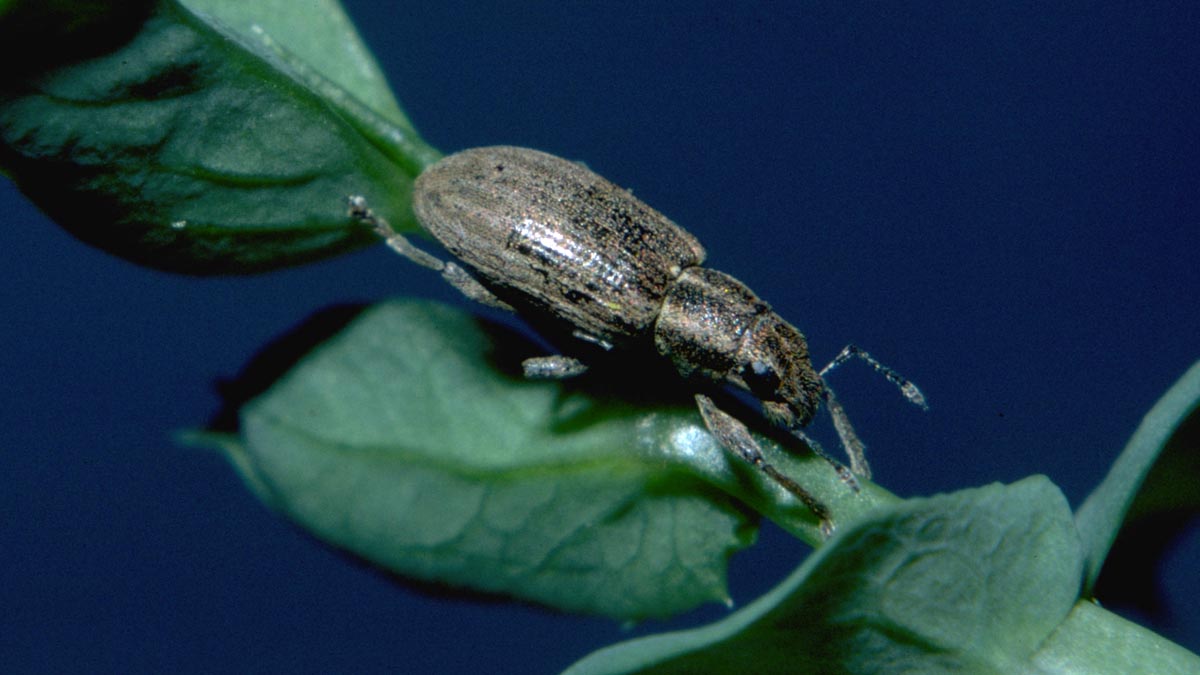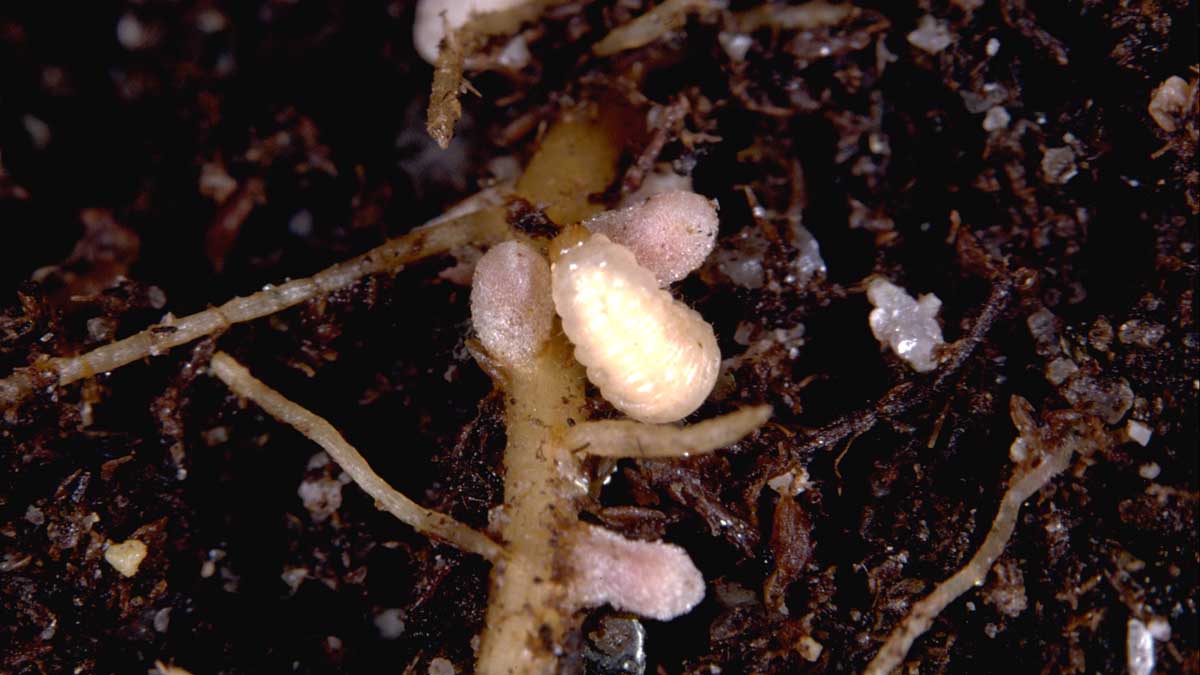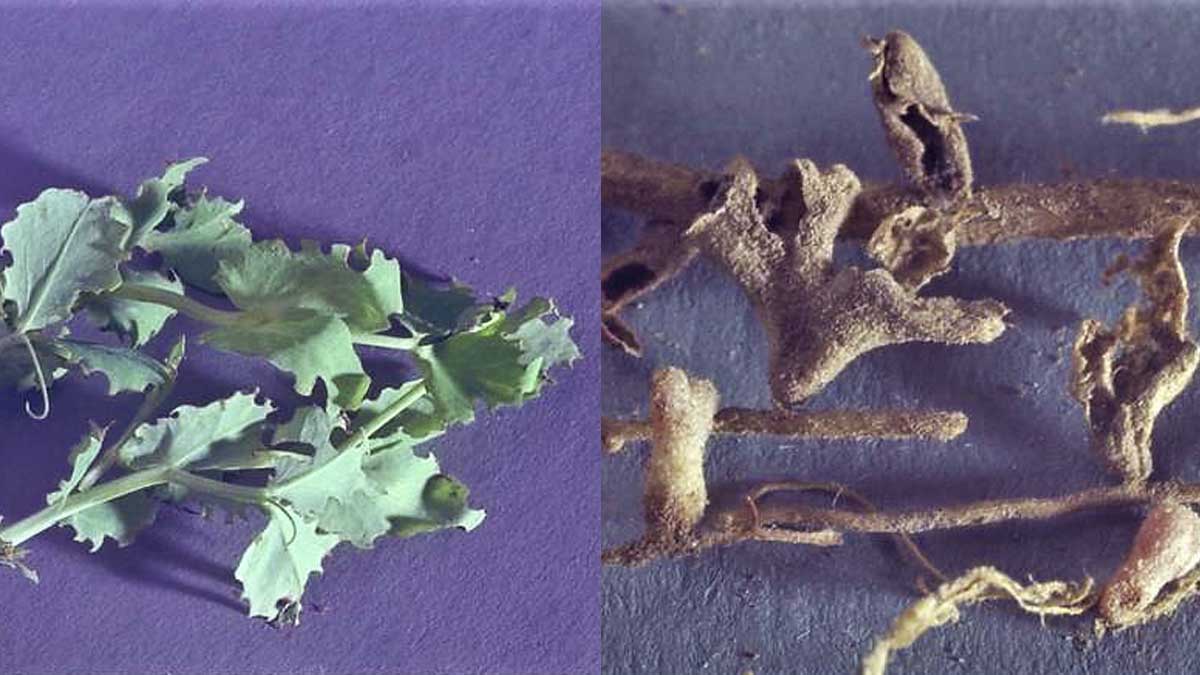Pea Leaf Weevils
Pest Common Name
- Pea Leaf Weevil (Sitona lineatus)
- Field pea and faba bean are preferred hosts, though many other legumes such as alfalfa, clover and vetch are also hosts
Adult pea leaf weevils are about 1/5 inch (5 mm) long, with a broad, blunt snout (Figure 1). They are grayish brown overall, with three light stripes extending from the thorax to the end of the abdomen. Adult pea leaf weevils may be mistaken for other Sitona spp. such as alfalfa curculio, but their stripping and size may help distinguish them.
Larvae range in size from 1/10-1/4 inch (3.2-6.4 mm). Larvae are legless, with a white body with dark brown head capsule, and curl into a “C” shape when disturbed (Figure 2).
Eggs are small and oval shaped, and are white when they are laid, but turn black near hatching.
Biology
Pea leaf weevil adults overwinter in alfalfa fields, field margins and perennial legumes. Once temperatures reach about 55 degrees Fahrenheit (13°C) pea leaf weevils begin to move into pea and faba bean fields to feed and mate. Each female can lay up to 3,000 eggs at the base of seedlings or in small crevices in soil. When these eggs hatch, larvae descend into the soil to feed on roots nodules of their host plant. Larvae pass through five stages or instars before pupating in the soil. In late summer the next generation of adults emerge and continue feeding before seeking overwintering sites.


Damage
Pea weevil larvae feed primarily on the roots and root nodules of legumes. This feeding can seriously damage the roots of the host plant, and in severe infestations can completely destroy the root nodules. Root nodules contain beneficial nitrogen fixing bacteria, so their destruction significantly reduces the plant’s ability to fix nitrogen. Without root nodules, the amount of nitrogen input to seeds and soil is severely reduced.
Adult pea leaf weevils also damage legume crops, most often causing characteristic scalloping of leaf edges with their feeding (Figure 3). Though they generally do not impact yield as heavily as larvae, when population numbers are extremely high adult feeding can kill young shoots.

Monitoring
As adult weevils are hard to count, action thresholds are based on observed plant damage (i.e., leaf notching). To determine if action is necessary early in the season, sample 10 sites in the field, five sites at the field edge and five sites 35 yards into the field. Sites should be about 25 yards apart. At each site, select 10 seedlings and note the proportion with leaf notches. If 30% or more of plants show damage, action may be necessary.
Later in the season, dig up plants to look for signs of larvae feeding on root nodules.
Management
Primary Management Tactics
Proper irrigation and fertilization (particularly with nitrogen) can help plants overcome pea leaf weevil damage. Broad spectrum insecticides should not be considered unless infestation is severe and other control measures have failed. Systemic insecticides are as effective as foliar sprays and better account for sporadic emergence; but currently there is no model available to accurately predict when pea leaf weevil population densities will warrant use of systemics. Due to this lack of a predictive model, the decision to treat needs to be made based on the regional and field history of pea leaf weevil population size and damage.
Cultural
- Plant later in season (approximately 10 days) to avoid peak weevil dispersal
- Facilitate plant development past vulnerable early stage before peak weevil dispersal
- Using no-till systems may reduce pea leaf weevil damage and foster populations of beneficial predators
Chemical
- Systemic insecticides are as effective as foliar sprays and better account for sporadic emergence, but it is difficult to predict in which years pea leaf weevil population densities will warrant use of systemics
- Timing applications of foliar insecticides is difficult, but they are most effective when applied before females lay eggs
- Recommendations for pesticides to use in the management of pea leaf weevil can be found on the PNW Pest Management Handbooks website.
Pesticide Warning
Always read and follow the instructions printed on the pesticide label. The pesticide recommendations in this University of Idaho webpage do not substitute for instructions on the label. Pesticide laws and labels change frequently and may have changed since this publication was written. Some pesticides may have been withdrawn or had certain uses prohibited. Use pesticides with care. Do not use a pesticide unless the specific plant, animal or other application site is specifically listed on the label. Store pesticides in their original containers and keep them out of the reach of children, pets and livestock.
Trade Names — To simplify information, trade names have been used. No endorsement of named products is intended nor is criticism implied of similar products not mentioned.
Groundwater — To protect groundwater, when there is a choice of pesticides, the applicator should use the product least likely to leach.
- Figures 1-2. Dennis Schotzko, University of Idaho
- Figure 3. Ken Gray, Insect Collection
Desiree Wickwar, Entomologist, IPM Program Manager
Sanford Eigenbrode, Distinguished Professor of Entomology
2023









